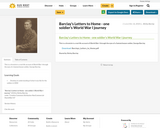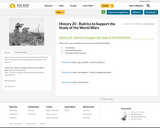
This is a chronicle is a real-life account of World War I through the eyes of a Saskatchewan soldier, George Barclay.
- Subject:
- History
- Social Studies
- Material Type:
- Reading
- Date Added:
- 10/16/2018

This is a chronicle is a real-life account of World War I through the eyes of a Saskatchewan soldier, George Barclay.

This comprehensive resource from Saskatchewan Rivers Public School Division includes units of study plus curricular and assessment resources for Grade 11 Arts Education, ELA, Physical Education and Wellness, Practical and Applied Arts, Mathematics, Sciences and Social Studies. Look for rubrics, unit plans, sample year plans (and templates), Treaty Education outcomes and indicators as well lots of other teacher resources. Some of the information is not available as a login is required.

In the 21CC project the students will put together a trunk full of artifacts or ‘keepsakes’ from the perspective anyone who would have lived through the 1920s and 30s. The truck has to demonstrate the change the occurred over that 20 year span. The artifacts must be tangible (not only a picture of an artifact but a picture could be an artifact); could be original or replica (made by them). It follows the 6 phases of creativity with a student project guide and an artifact presentation rubric.

Learning Outcomes
Knowledge Objectives (K) - The student will:
1. Know that all nations must determine how to use their available human and material resources and that determination will involve choices among perceived/real demands on those resources.
2. Know that scarcity is the relationship that occurs because the unlimited wants exceeds the limited resources available to meet those wants.
3. Know that major events/situations such as wars will affect the resources a nation has available and will influence how those resources are used.
4. Know that distinct populations will seek to have control over the decision making process which affect their lives.
5. Know that groups seeking to fulfill their agendas have a number of alternative methods to achieve those agendas including the use of violent and nonviolent tactics.
6. Know that nations will sometimes consider certain geographic regions, including other nations, as being strategic importance to their interests and will seek to have a preponderance of influence over that region.
7. Know that every society has to establish some fundamental criteria that can be used to justify the allocation of supreme power within that society to certain individual or groups.

These rubrics were developed to aid in the study of the World Wars
Gas Warfare
Historical Newspaper
Description of the trenches